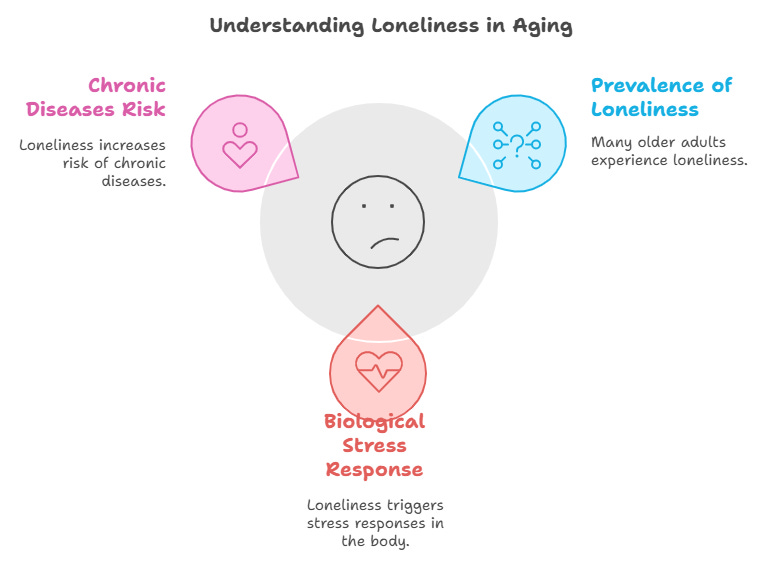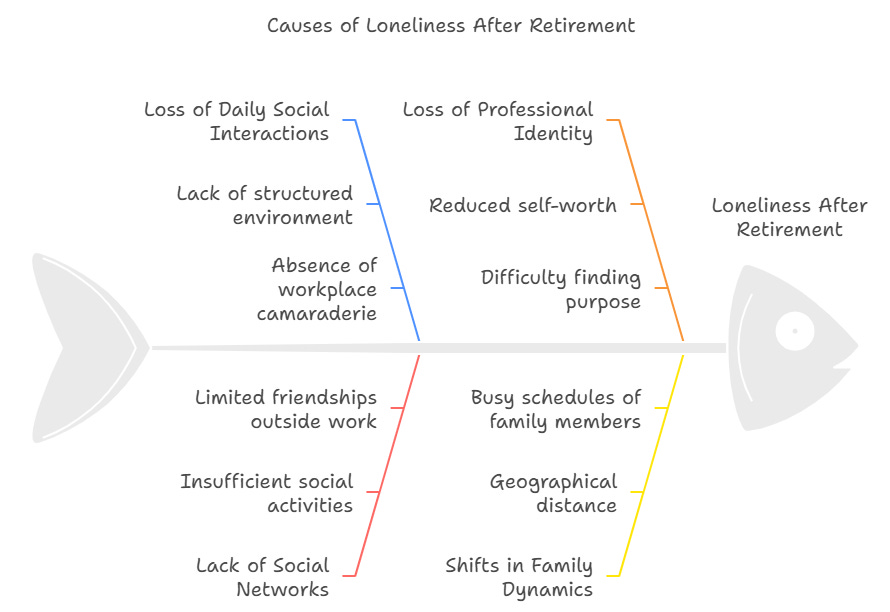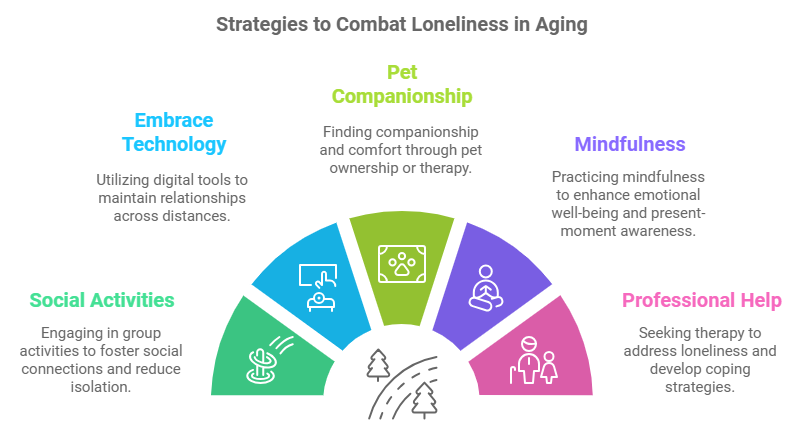Loneliness in Retirement: The Hidden Mental Health Crisis No One Talks About
How to Overcome Isolation and Build Meaningful Connections in Your Golden Years
Loneliness is a silent but devastating force that often infiltrates the lives of older adults. For many retirees, the absence of daily social interactions leads to a deep sense of isolation that can take a significant toll on both mental and physical health. While the impacts of loneliness have been widely underestimated, research by Prof John Cacioppo and others has shown that the effects of loneliness can be as damaging as chronic health conditions like heart disease or smoking.
In this newsletter, we will explore the causes of loneliness in older adults, the mental and physical health risks associated with it, and actionable strategies for combating it. This guide offers practical solutions to help you or your loved ones stay socially connected, mentally resilient, and physically healthy as you age.
The Silent Struggle of Loneliness in Aging
Loneliness in older adults is often described as an "invisible" crisis because it’s hard to see from the outside, yet the effects are incredibly profound. Studies show that nearly one in three older adults experiences loneliness. While this may seem like an emotional issue, the science tells us that loneliness goes much deeper, affecting every aspect of health.
In his research, John Cacioppo, a pioneering scholar in the field of social neuroscience, found that chronic loneliness triggers a biological stress response. This is not just psychological; loneliness activates the hypothalamic-pituitary-adrenal (HPA) axis, the same system that manages the body’s fight-or-flight response. Over time, this ongoing stress weakens the immune system and raises the risk for chronic diseases like heart disease, high blood pressure, and diabetes.
The impact of loneliness is further compounded by the fact that it often goes unnoticed by those around the individual. Unlike physical ailments, loneliness is silent, which makes it harder to diagnose and address, leaving many older adults feeling invisible and unsupported.
How Loneliness Affects Mental Health in Older Adults
What Are the Psychological Effects of Loneliness?
Loneliness doesn’t just affect emotional well-being; it profoundly impacts mental health. Cacioppo’s work emphasized that social isolation contributes directly to the development of mental health disorders, such as depression, anxiety, and even cognitive decline. When older adults are socially isolated, they are less likely to engage in conversations or activities that stimulate their brain, leading to a greater risk of dementia.
The National Institute on Aging (NIA) supports these findings, showing that loneliness is linked to higher rates of early mortality and severe cognitive impairment. In fact, socially isolated individuals are 50% more likely to suffer from dementia than those who have regular social interactions. Over time, loneliness can also erode self-esteem, leaving older adults feeling unworthy, especially after significant life changes like the loss of a spouse or transitioning into retirement.
Researchers such as Dr. Carla Perissinotto of UCSF also underline the long-term effects of isolation, stating that loneliness has as much of an impact on mortality as smoking or obesity. For many older adults, loneliness exacerbates existing mental health issues, creating a feedback loop where mental health declines make it harder to seek out social connections, which in turn deepens feelings of isolation.
Why Loneliness Increases After Retirement
What Makes Retirement a Trigger for Loneliness?
Retirement is often viewed as a reward for years of hard work, but for many, it marks the beginning of a difficult emotional journey. One of the most significant changes in retirement is the sudden loss of daily social interactions that come with work. This loss can be particularly stark for individuals who have not built social networks outside of their jobs. The lack of structure can lead to feelings of disconnection and purposelessness, making it easy for loneliness to take root.
The Harvard Study of Adult Development, the longest-running study on adult life, reveals that close relationships are key to happiness and longevity. Without the daily interactions provided by work, retirees often feel a significant void. The loss of professional identity can also affect one’s sense of self-worth. In Erik Erikson’s psychosocial theory, this stage of life requires individuals to find meaning and integrity, but many retirees find it difficult to do so without a structured environment. This is what scholars call existential loneliness, where individuals struggle to find their place and purpose after leaving the workforce.
Additionally, family dynamics often shift in retirement. Many retirees find themselves distanced from their adult children or grandchildren, either geographically or due to busy schedules, leaving fewer opportunities for interaction. This isolation can lead to feelings of abandonment, exacerbating loneliness.
The Health Risks of Loneliness: From Heart Disease to Dementia
How Does Loneliness Impact Physical Health?
The physical health risks associated with loneliness are often overlooked, but they are as serious as any chronic illness. According to the Proceedings of the National Academy of Sciences, social isolation increases mortality risk by 26-32%, similar to the risks associated with smoking and obesity. Loneliness triggers chronic inflammation, which has been linked to heart disease, high blood pressure, and other cardiovascular issues.
Social isolation also accelerates cognitive decline. Seniors who live alone or are socially isolated are more likely to develop Alzheimer’s disease and other forms of dementia. The Alzheimer’s Association reports that older adults with strong social networks tend to maintain cognitive function longer and have a reduced risk of developing dementia compared to those who are isolated.
Sleep disturbances are another significant physical consequence of loneliness. Older adults who experience loneliness often suffer from insomnia or disrupted sleep patterns, which further weakens the body’s ability to heal and cope with stress.
Effective Strategies to Combat Loneliness in Aging
How Can Older Adults Rebuild Connections?
While loneliness in aging is a serious issue, it is far from inevitable. There are several effective strategies older adults can adopt to reconnect with others and improve both their mental and physical health:
Join Social Activities
Social engagement is key to overcoming loneliness. Joining local senior centers, volunteer groups, or even book clubs provide older adults with structured social interaction. Stanford University’s research shows that regular group activities increase well-being and decrease feelings of isolation. Whether it’s a weekly fitness class or a coffee morning with neighbors, these small interactions can help rebuild social bonds.Embrace Technology
Technology offers new ways to stay connected with loved ones. Tools like Zoom, Skype, and social media platforms can bridge physical distances and enable older adults to maintain meaningful relationships, even with family members who live far away. Community centers often offer tech workshops to help older adults learn how to use these platforms.Consider Pet Companionship
Pets can provide much-needed companionship. Research from the Human Animal Bond Research Institute (HABRI) has shown that owning a pet significantly reduces feelings of loneliness and lowers stress levels. For those who can’t own pets, pet therapy programs are an excellent alternative that brings animals to visit seniors in assisted living facilities or at home.Practice Mindfulness
Mindfulness is another powerful tool in combating loneliness. Studies from UCLA’s Mindful Awareness Research Center show that mindfulness practices can help reduce negative thinking patterns associated with isolation and improve emotional well-being. Mindfulness encourages individuals to live in the present moment, reducing the mental spiral that can come with feeling isolated.Seek Professional Help
For those who find loneliness overwhelming, seeking help through cognitive-behavioral therapy (CBT) is an effective way to address both loneliness and depression. Therapy provides a safe environment for older adults to discuss their feelings and develop coping mechanisms that will help them better manage their emotional state.
The Role of Communities in Reducing Loneliness
What Can Communities Do to Help?
Communities play an essential role in reducing loneliness among older adults. Age-friendly infrastructure and intergenerational programs can make a huge difference in helping seniors stay connected. Communities that foster connections between younger and older generations create a sense of purpose for retirees, helping them feel valued and integrated.
Programs like RSVP (Retired Senior Volunteer Program) offer retirees the opportunity to volunteer, which gives them a sense of purpose and social interaction. Moreover, cities designed with senior-friendly policies, like accessible public spaces, transportation, and social programs, can significantly reduce isolation. The World Health Organization’s Age-Friendly Cities Initiative encourages cities to adopt these policies to promote inclusion and well-being for older adults.
Addressing the Stigma Around Loneliness
Why Is Loneliness Stigmatized and How Can We Change This?
Many older adults feel ashamed to admit they are lonely, partly due to societal stigma. Loneliness is often seen as a weakness or personal failure, which discourages people from reaching out for help. However, it’s important to recognize that loneliness is a widespread and legitimate health concern, not a personal flaw.
The Campaign to End Loneliness suggests that we can combat this stigma by normalizing conversations about isolation. Families, communities, and healthcare providers can encourage open dialogue, reducing the shame associated with loneliness and making it easier for older adults to seek support. Providing safe spaces like support groups and promoting mental health resources can also help reduce the stigma.
Conclusion: Building a Life Full of Connection in Retirement
Loneliness is a serious health issue, but it doesn’t have to define retirement. With the right steps, retirees can rebuild social connections, improve their mental and physical health, and enjoy a fulfilling, connected life. Whether it’s joining a new group, embracing technology, or seeking professional counseling, every step toward connection matters.
If you or a loved one is struggling with loneliness, don’t hesitate to reach out. Explore resources like the Campaign to End Loneliness and John Cacioppo’s research on loneliness to learn more about how you can combat isolation and improve well-being in aging.
Remember, you’re never truly alone—and there’s always a path back to connection.







